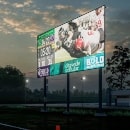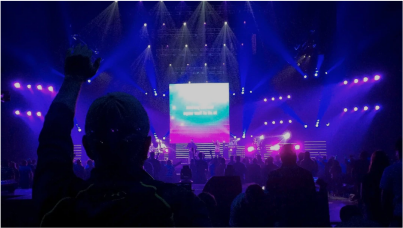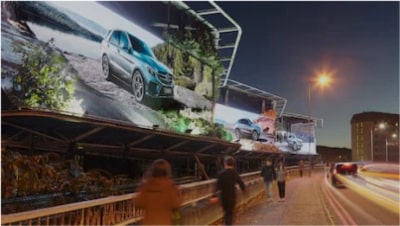How do Digital Billboards Work?
From the underlying technology to their environmental benefits, this guide aims to provide a thorough understanding of how digital billboards work. Whether you're a business owner contemplating a foray into digital outdoor advertising, or simply a tech enthusiast curious about the mechanics behind these vivid displays, this article offers valuable insights.
What are Digital Billboards?
Digital billboards are a leap forward in outdoor advertising, representing a significant shift from traditional static billboards. These high-tech displays use clusters of bright, light-emitting diodes (LEDs) to project vivid images and text. Unlike their static counterparts, digital billboards offer the flexibility to update content remotely and rapidly, enabling advertisers to display multiple messages throughout the day.
The core essence of a digital billboard is its dynamic nature. They are equipped to change advertisements every few seconds, allowing multiple advertisers to share the same space efficiently. This dynamic feature is not just about rotating ads; it's about tailoring messages to the time of day, audience demographics, or even current events, making them highly relevant and engaging.
Moreover, digital billboards stand out for their brightness and clarity, which are essential in attracting attention in both daylight and nighttime conditions. They are designed to be highly visible from long distances and under various lighting conditions, ensuring that the displayed content is always clear and impactful.
In essence, digital billboards are a fusion of cutting-edge technology and creative marketing strategies, offering an innovative platform for businesses to communicate with their audience. This technology has revolutionized outdoor advertising, allowing for more dynamic, flexible, and engaging content delivery.
Key Advantages of Digital Billboards
1. Dynamic Content
The dynamic content capability of digital billboards is a game-changer in advertising. This feature allows for the display of varying content at different times, catering to different audience segments. For instance, a breakfast item can be advertised in the morning, while dinner specials can be highlighted in the evening. This flexibility ensures that the content is relevant and engaging to the viewers at any given time.
2. Targeted Advertising
Digital billboards enable targeted advertising like never before. With the ability to change content quickly, advertisers can tailor their messages to specific demographics, times of day, or even current events. This targeted approach ensures that the advertisements are more relevant to the viewers, leading to higher engagement rates and a better return on investment.
3. Cost-efficiency
Unlike traditional billboards that require physical production and installation of a new advertisement for each campaign, digital billboards eliminate these material and labor costs. The ability to digitally upload content means that more campaigns can be run in the same timeframe, reducing the overall cost per ad. This cost-efficiency makes digital billboards an attractive option for businesses of all sizes.
4. Environmental Benefits
Digital billboards are more environmentally friendly compared to traditional billboards. They eliminate the need for vinyl and other materials used in traditional billboards, reducing waste. Additionally, modern LED technology used in digital billboards is energy-efficient, consuming less power and minimizing the environmental footprint.
The Technology Behind Digital Billboards
LED Display Technology
1. Types of LEDs Used
Digital billboards predominantly utilize two types of LED technology: Surface-Mount Device (SMD) and Discrete LEDs. SMD LEDs are commonly used for high-definition screens in urban areas due to their ability to provide clear images even at close distances. Discrete LEDs, on the other hand, are often used in larger billboards along highways, as they are visible from greater distances.
2. Pixel Pitch and Resolution
Pixel pitch, referring to the distance between the centers of two adjacent pixels, is a critical factor in determining the resolution of a digital billboard. A smaller pixel pitch means a higher resolution, allowing for clearer and more detailed images. The choice of pixel pitch depends on the viewing distance and the intended use of the billboard.
3. Color Calibration and Reproduction
Color calibration is essential for maintaining the consistency and accuracy of the images displayed. Advanced digital billboards are equipped with sophisticated calibration technology to ensure that colors are vivid and true to life, enhancing the overall impact of the advertisement.
4. Brightness and Visibility
The brightness of digital billboards is crucial for visibility, especially under direct sunlight. Modern LED screens are capable of adjusting their brightness based on ambient light conditions, ensuring that the content is always visible and attractive to passersby.
Content Management Systems (CMS)
Content management systems are at the heart of digital billboard operations. They allow for the remote uploading, scheduling, and managing of content. A robust CMS is user-friendly and offers features like real-time previews, scheduling tools, and analytics to track the performance of ads.
Connectivity and Remote Management
Remote management and connectivity are essential for the efficient operation of digital billboards. They are typically connected via wired or wireless networks, allowing operators to update content from anywhere, at any time. This connectivity also facilitates real-time monitoring and troubleshooting, ensuring minimal downtime and maximum efficiency in advertising campaigns.
Installation and Maintenance
Site Selection and Permitting
1. Choosing the Right Location
The effectiveness of a digital billboard largely depends on its location. Ideal locations are highly visible, have high foot or vehicle traffic, and are situated in areas where the target audience frequents. Careful consideration must be given to factors like sightlines, surrounding buildings, and viewer orientation to maximize visibility and impact.
2. Regulatory Considerations
Before installation, it's crucial to understand the local regulations regarding digital billboards. This includes size restrictions, brightness levels, and content regulations. Compliance with these rules is essential to avoid legal issues and ensure community acceptance.
Installation Process
1. Mounting and Rigging
Installing a digital billboard requires precision and expertise. The process involves structurally supporting the screen, ensuring it can withstand local weather conditions. Proper mounting and rigging are crucial for the longevity and safety of the billboard.
2. Electrical Connections
Digital billboards require a reliable power source and appropriate electrical connections. This step should be handled by certified professionals to ensure the system's safety and efficiency.
3. Content Upload and Testing
Once the billboard is installed, the initial content is uploaded, and thorough testing is conducted. This phase ensures that all components are functioning correctly, and the display quality meets the expected standards.
Ongoing Maintenance
1. Routine Inspections
Regular inspections are vital to maintain the optimal functioning of digital billboards. These checks include assessing the structural integrity, LED quality, and electrical connections.
2. Troubleshooting Common Issues
Common issues like pixel failure, connectivity problems, or software glitches need to be promptly addressed to minimize downtime. Having a responsive maintenance team is crucial for the quick resolution of these issues.
3. Upgrades and Repairs
Over time, technology advancements may necessitate upgrades to the billboard system. Additionally, repairs may be required to address wear and tear. A proactive approach to upgrades and repairs ensures the billboard remains state-of-the-art and operates reliably.
Content Creation and Strategy
Creating Effective Digital Billboard Content
1. Design Principles
Designing for digital billboards requires understanding the unique context in which the content will be viewed. The content should be visually striking, with clear and concise messaging. Use of large, readable fonts and high-contrast colors ensures legibility from a distance. Simplicity is key – cluttered designs can be difficult to comprehend, especially for viewers who are in motion.
2. Dynamic vs. Static Content
Dynamic content, which changes periodically, can be more engaging than static content. It allows for time-sensitive advertisements and can keep the audience's interest piqued over time. However, the choice between dynamic and static billboard content should be based on the campaign's objectives and the intended audience.
3. Call-to-Action Elements
A strong call-to-action (CTA) is crucial for driving audience engagement. Whether it’s encouraging viewers to visit a website, attend an event, or take advantage of a sale, the CTA should be clear and compelling.
Targeting and Scheduling
1. Identifying the Target Audience
Understanding the demographic and psychographic characteristics of the target audience is vital for effective billboard content. This knowledge helps in creating tailored messages that resonate with the audience.
2. Dayparting and Campaign Scheduling
Dayparting involves scheduling different content at different times of the day to target specific audience segments. For example, advertising breakfast items in the morning and dinner specials in the evening. Effective campaign scheduling maximizes the impact of the advertisement by aligning it with the audience's habits and preferences.
Data Analytics and Performance Measurement
1. Tracking Impressions and Click-Through Rates
Advanced digital billboards can track impressions and, in some cases, click-through rates when integrated with mobile technology. This data is invaluable for measuring the effectiveness of a campaign and making informed adjustments.
2. ROI Analysis
Return on Investment (ROI) analysis helps advertisers understand the effectiveness of their billboard campaigns in terms of audience reach and engagement relative to the cost. Continuous analysis and adjustment based on this data can significantly improve the effectiveness of future campaigns.
Legal and Ethical Considerations
Compliance with Advertising Regulations
1. Local and National Laws
Navigating the legal landscape is critical for digital billboard operators. This involves adhering to local and national laws regarding outdoor advertising. These laws can vary significantly and may cover aspects such as billboard size, location, content restrictions (like prohibitions on advertising alcohol or tobacco), and brightness levels. Failure to comply with these laws can result in fines, legal action, or the removal of the billboard.
2. Advertising Standards
Beyond legal requirements, digital billboards must adhere to established advertising standards. These standards aim to ensure that content is not misleading, offensive, or inappropriate. Compliance with these standards is not only a legal obligation but also a matter of corporate responsibility and public image.
Privacy Concerns and Data Protection
As digital billboards become more advanced, incorporating technologies like cameras or mobile integration for interactive content, privacy concerns come into play. Operators must ensure that any data collection complies with privacy laws and is transparent to the public. Data protection is paramount to maintain public trust and avoid legal complications. This includes securing any personal data collected and using it responsibly.
Cost and Budgeting
Initial Investment
1. Hardware Costs
The primary cost component in digital billboards is the hardware, which includes the LED display, control systems, and structural components. The price varies significantly based on the size of the billboard, the quality of the LED display (resolution and brightness), and additional features like weatherproofing.
2. Installation Expenses
Installation costs encompass mounting the billboard, electrical work, and integrating the display with content management systems. These costs can vary based on the complexity of the installation site and the specific requirements of the billboard.
Ongoing Expenses
1. Electricity Costs
Digital billboards require a continuous power supply to operate. The cost of electricity will depend on the size of the billboard, its brightness, and local energy prices. Using energy-efficient LED technology can help in reducing these costs.
2. Content Creation and Management Fees
Regularly updating the content on digital billboards involves costs related to graphic design and content management. These expenses can vary based on the frequency of content changes and the complexity of the designs.
3. Maintenance and Repairs
Routine maintenance is necessary to ensure the longevity and optimal performance of digital billboards. This includes cleaning, inspecting, and repairing any damaged components. Setting aside a budget for unexpected repairs is also advisable.
ROI Calculation and Long-term Benefits
Calculating the return on investment (ROI) for digital billboards involves evaluating the costs against the benefits, such as increased audience reach and engagement. While the initial investment may be significant, the long-term benefits, including the ability to run multiple campaigns and the potential for higher engagement rates, often justify the expenditure. Proper budgeting and cost management are key to maximizing the ROI of digital billboards.
Choosing the Right Digital Billboard Solution
Evaluating Your Advertising Goals
Before selecting a digital billboard, it's crucial to have a clear understanding of your advertising goals. This includes identifying the target audience, the desired impact of the campaign, and the specific objectives you wish to achieve. Whether it's brand awareness, promoting a sale, or providing public information, the goals will significantly influence the type of digital billboard solution you choose.
Sizing and Resolution Considerations
The size and resolution of the billboard should align with where it will be located and how far away viewers will be. For high-traffic urban areas where viewers are closer, higher resolution and smaller screens might be more effective. Conversely, for billboards along highways or at significant distances, larger screens with lower resolution may be more appropriate.
Vendor Selection
When selecting a vendor for digital billboards, it's important to consider not just the cost but also the quality and reliability of their products. Ultravision LED Solutions stands out in this regard. Our expertise in providing high-quality, durable, and technologically advanced digital billboards ensures that your investment is not just a purchase, but a long-term asset. We offer tailored solutions, considering factors like location, viewing distance, and specific client needs, to ensure that your digital billboard effectively communicates your message.
Integration with Existing Systems
The integration of the digital billboard with existing content management and advertising systems is vital. Ensuring compatibility and ease of use in content upload and scheduling can save time and resources in the long run. It's important to choose a solution that seamlessly integrates with your current systems and workflows.
Selecting the right digital billboard solution is a critical decision that requires careful consideration of your advertising goals, the specifications of the billboard, the quality and reliability of the vendor, and the compatibility with existing systems. Making an informed choice will ensure that your digital billboard effectively meets your advertising needs and delivers the desired impact.
Ultravision LED Solutions: Industry Leading Digital LED Billboards
At Ultravision LED Solutions, we pride ourselves on being industry leaders in providing state-of-the-art digital LED billboards. Our commitment to innovation, quality, and customer satisfaction sets us apart in the digital display landscape.
Our digital billboards are not just products; they are comprehensive solutions tailored to meet the unique needs of each client. From the bustling streets of major cities to the quiet roadsides of rural areas, our LED displays are designed to deliver unparalleled performance. We understand the importance of visibility, durability, and quality in outdoor advertising. That’s why our screens offer superior brightness, high resolution, and robust construction, ensuring that your message stands out and endures, regardless of the environment.
Moreover, our team at Ultravision LED Solutions provides end-to-end support, from initial concept and design to installation and maintenance. We collaborate closely with our clients to understand their objectives and offer customized solutions that maximize their investment. Our advanced content management systems are user-friendly and versatile, allowing for seamless content updates and effective campaign management.
Choosing Ultravision LED Solutions means partnering with a team that’s dedicated to pushing the boundaries of digital billboard technology. We invite you to explore our range of digital billboards and discover how our innovative solutions can elevate your advertising strategy. Join us in shaping the future of digital outdoor advertising and make a lasting impression in the market.










